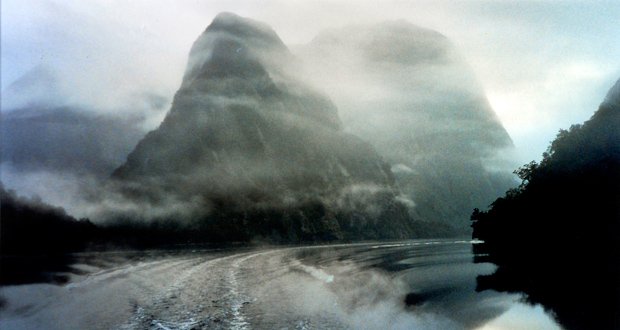Fiordland: Sounds of silence

ON THE WESTERN EDGE of Lake Manapouri at the West Arm visitors centre, a sign reminds visitors of the reality of New Zealand’s remote Fiordland: Welcome to (nearly) the edge of the world.
It’s taken a 40m boat ride to get this far, and a similar length bus trip is next before it’s time to board an overnight cruise on Doubtful Sound – one of the few ways to enjoy an unhurried experience of the 1.2 million hectares of World Heritage-listed rainforest.
Most visitors to the area don’t even get this far, instead opting for a drive along the Te Anau highway to Milford Sound, before a short (2hr) cruise. While there’s no doubting this option is spectacular, ‘well trodden’ is an understatement. To experience the serenity of Fiordland without the muddy walking of the Milford or Kepler tracks, a night out on Doubtful Sound is ideal.

Thundering waterfalls of Doubtful Sound, NZ
Fiordland like Antarctica
Fiordland holds a special place in the hearts of New Zealanders.
“It’s like Antarctica is for Aussies – so wild you wouldn’t want to get stuck there by yourself,” says Neville Peat, an author and photographer who has written about the area for decades.
On a trip like the overnight ones offered by Fiordland Expeditions, you’re unlikely to get stuck, but it is probable you’ll have the 40km of winding waterways of Doubtful Sound mostly to yourself. This rainforested region is virtually unwalkable, so being out on the water is a unique opportunity to ponder the rounded mountains of this section of the sounds and contemplate the successive glaciations of the Pleistocene area which have pounded them into submission.
Assuming there’s some rain (the odds are on; the area receives about 7m of rainfall a year), you’ll want to head to the upper deck for the 360 degree view of dozens of temporary waterfalls thundering over the surrounding cliffs into the 420m-deep waters below.
It feels like ancient territory, but as Neville confirms, it’s not as far removed from Australia as it appears.
“We’re a chip off the block of Gondwana. The separation began about 85 million years ago,” says Neville.
The rainforest-clad mountains which make a visit to Fiordland so spectacular are about 5-10 million years old, while the fiords (incorrectly known as sounds), at 2 million years, are relative newcomers.
While there are 14 fiords in the region, Milford and Doubtful are the easiest to access. The latter remains the locals’ favourite; it’s significantly longer than Milford, which is easy to cruise through in a couple of hours (and every day, thousands do). On Doubtful, small vessels like ours take their time, meandering past the beech forest and stopping occasionally for fishing, kayaking, or diving for a crayfish dinner.
Experiencing the majestic scenes of New Zealand
Although kayaking is a highlight, it’d take a hungry tourist to jump into the 12ºC darkness of Doubtful Sound. “The massive rainfall creates tannin stains in the sea water, causing a dark veil of freshwater to float on top,” says Pete McMurtie, a ranger with Department of Conservation in nearby Te Anau.
The result creates a diving environment that mirrors the deep sea only metres below the surface. “The tannin layer filters all the light, so you get a lot of deepwater species here, like black coral – which is actually white, till you pull it out of the ocean,” he says.
Given the water temperatures, most visitors choose to stay above the surface, keeping their eyes peeled for the dolphins, seals and penguins that are more commonly seen here than Milford. When Pete visits, he’s more interested in what shouldn’t be here.
For one, they’ve done a lot of pest-eradication work on Secretary Island, he says. “It’s quite unique as it’s never had any rodents, only stoats and deer, so we’ve been able to introduce a number of rare species there, like the Takahe, a flightless bird, and the North Island Kokako, a wattle bird that gurgles from the trees,” he says.
But while the gurgling of birdlife is becoming more prevalent thanks to programs like Pete’s, in this vast slice of wilderness most visitors find it’s the alternating noise of the thunderous waterfalls with the sounds of silence that deliver the planet’s most important natural history lesson.
“You realise nature is much more powerful than anything we can contrive and build,” says Neville.
RELATED STORIES

